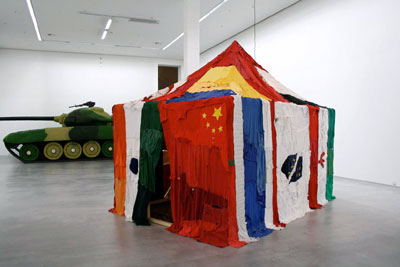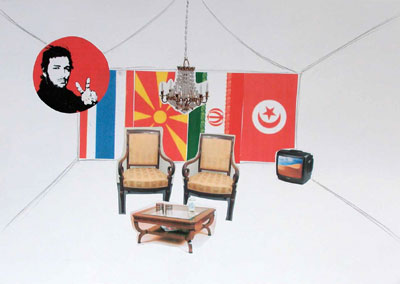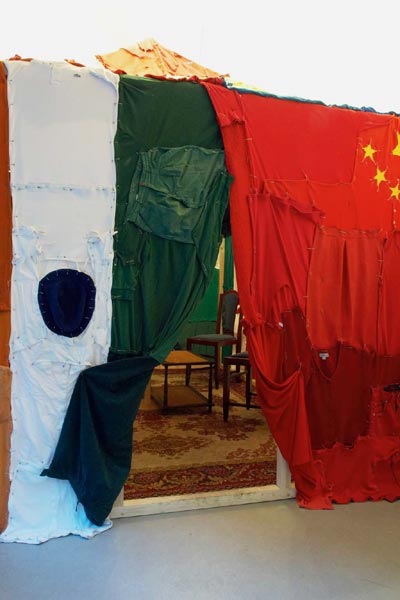Of Huts and Tents
Huts made in the context of art from cardboard boxes and planks stand as symbols of the cardboard cities and shantytowns – these rhizomesque proliferating extemporised settlements – on the margins of modern metropolises. In his new works, Costa Vece turns to the image of the tent.

«Revolucion Patriotismo», Costa Vece, 2006
Yet the tent does not serve here as a metaphor for romantic holidays and childhood games,(1) nor does it point to the authenticity of nomadic peoples whose lives are founded on freedom, independence and flexible mobility. On the contrary, the tent calls to mind global catastrophes. Vast tented cities serving as refugee camps throughout the world – once intended as no more than temporary shelters – have been home to millions for years now.

Installation view, Berlinische Galerie, 2007
The tent, kitted out with the bare necessities of Western civilisation – chairs, a lamp and a table – becomes a shelter that supposedly offers protection. The television, an additional light source and sign of contact with the outside world- all is transfigured as an instrument of fiction. As though reality were more bearable if it is explained with the tag ‘like in a film’. Escape into a fantasy world and the stuff that dreams are made of may provide a momentary way out, but the reality of this claustrophobic state can only temporarily forgotten. Images of recurrent catastrophes underline the fact that there is no way of escaping reality. They flicker across the television screen like the shadows of the people chained in the light of the fire in Socrates’ cave.

«Revolucion Patriotismo», Costa Vece, 2006
The national flags that Costa Vece’s tent is made of, symbolically represent people from non-European countries who make up the throngs of immigrants, asylum seekers and ‘illegals’ who so often have to fritter away their lives in exploitative conditions of production and service and who can only operate in the grey areas on the margins of society, wanted neither here nor there. The used socks, T-shirts, jeans and jackets that the flags are cobbled together from point to their distant places of origin, which are often the same as the addresses on aid deliveries. Conflict zones in places such as Kashmir, Darfur, Kukuma, Bangladesh, Thailand or the favelas of Brazil are often no more than a stone’s throw from cheap-labour production plants. The circulation of goods comes full circle and feeds into the re-use of items in the construction of a work of art.

Installation view, Galerie Georg Kargl, Vienna, 2006
The tent embodies both a hope and a curse. It has little scope for intimacy. Protection from extreme weather conditions and for one’ self can only ever be relative. However small a tent, however meagre a hut, it can still hold out the promise of escape from misery. It is imbued with human beings’ ability to leave nothing undone that might help to restore a person’s dignity. The curse is that those intentions which were originally intended as temporary solutions have now become a permanent state for so many, and will continue to be so.

«Revolucion Patriotismo», Costa Vece, 2006
Once a people’s misery has lost the attention of the media, interest in it ebbs away and, with it ebbs, the hope that things may ever change for the better. Sustainable improvements in people’s living conditions also require changes in political structures and economic interests.
(1) Cf. Michel Foucault, France Culture, 1966, publ. Utopies et Hétérotopies, INA, Paris, 2004
Picts- and text material: photo (installation view total) by Erla S. Haraldsdottir, «Neue Heimat», Berlinische Galerie, 2007; photo (installation view close up) by Rastl, Galerie Georg Kargl, Vienna, 2006. Drawings, «Revolucion Patriotismo», by Costa Vece (photo document by Rastl), courtesy: Galerie Georg Kargl, Vienna, 2006. Text by Rayelle Niemann, Zurich, 2006; extract of the text «From Outside and Inside» published in the catalogue: Costa Vece; «Dark Days», Kunstmuseum Solothurn, edition fink, Zurich, Switzerland, 2006.
[ top ]
RELATED WEB SITES
→ Costa Vece at Wikipedia
→ Vece at Fondazione Volume
→ Vece at Galleria Franco Noero
[ A Stroll through Cairo and Time ]
[ Capital Presents ]
[ cheek ]
[ Dispositions ]
[ Drivers’ comment ]
[ E’laan—Call for Job ]
[ Going for a Ride ]
• Of Huts and Tents •
FEATURED THEME ON CITY SHARING
by ASUNCION MOLINOS GORDO
-
This project is an instrument for common critical analysis to help understand the reasons behind Egyptians’ diminishing …
by INAS HALABI
-
The project Letters to Fritz and Paul focuses on the expeditions of the Swiss cousins, lovers and scientists, Fritz and …
by SARAH BURGER
-
The planned modern city of Brasilia attracted me since a long time. Her defined shape, location and function proceded he …
by ADRIEN GUILLET
-
Youri Telliug talks with the artist Adrien Guillet about his project Citracit
Youri Telliug - What is Citracit …
by NIGIST GOYTOM
-
In 2013 more than 45 million people have been forced to leave their homes. This amounts to the biggest number of refugees …
by SULAFA HIJAZI
-
The on going debate on Arab identity and its (cultural) representation is strongly shaped by Edward Saidʼs formative …
by ASUNCION MOLINOS GORDO
-
WAM is a site-specific work that uses the historical trope of the cabinet of curiosities to explore the introduction of …
MORE CONTRIBUTIONS BY THE FOLLOWING